|
/ intro / story page 1 / story page 2 / photo index / 
p a g e 2
Bran
The next day we moved on in the directing of Brasov and the nearby located famous castle of Bran. Barbara had to drive that day because I was not at my best yet after the evening before. In the afternoon we arrove in Bran we're we stoped at a hotel located in walking distance of castle Bran. 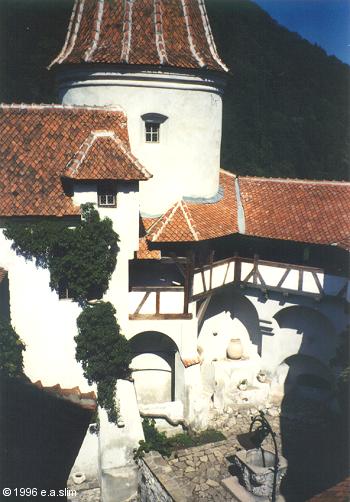 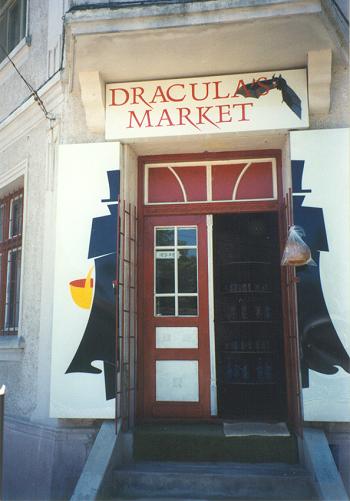 At that moment it started to rain very hard (the only day we had bad weather) so we didn't do anything the rest of the day except having a good diner in the hotel, taking a nice shower (a luxury on this trip) and reading some books. At that moment it started to rain very hard (the only day we had bad weather) so we didn't do anything the rest of the day except having a good diner in the hotel, taking a nice shower (a luxury on this trip) and reading some books.
In the morning of the sixth day of our trip we walked from our hotel to castle Bran. This castle was built in 1377 situated on the border between transylvania and Wallachie to protect the land against the turks. This castle has nothing to do with our fellow Dracula although the romanians wants you to believe otherwise. Because of the fact that the castle is totally intact and has a very nice dark atmosphere you could imagine that Dracula has lived here, something that many ignorant tourists do. We visited this very beautiful castle and I made a few nice photographs from the inside and outside of the castle.
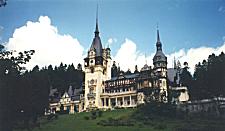 After that we drove to Sinaia, a city southward from Brasov were we visited one of the most touristic highlights of Romania: manorhouse Peles. This royal residence was built by king Carol 1 in 1883 and is still filled with beautiful furniture and more royal luxury. Manorhouse Peles has been kept very well. One of the main reasons for that is that former romanian dictator Ceausescu did not stayed much in it because he thought there were mildews in it.... After that we drove to Sinaia, a city southward from Brasov were we visited one of the most touristic highlights of Romania: manorhouse Peles. This royal residence was built by king Carol 1 in 1883 and is still filled with beautiful furniture and more royal luxury. Manorhouse Peles has been kept very well. One of the main reasons for that is that former romanian dictator Ceausescu did not stayed much in it because he thought there were mildews in it....
Tirgoviste
From Sinaia we drove more to the south of the country called Wallachie. Again we crossed the Carpathians and at the end of the evening we arrove at the grey industry-city called Tirgoviste where the Vlad Tepes castle is located.
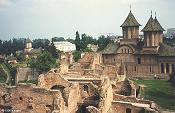 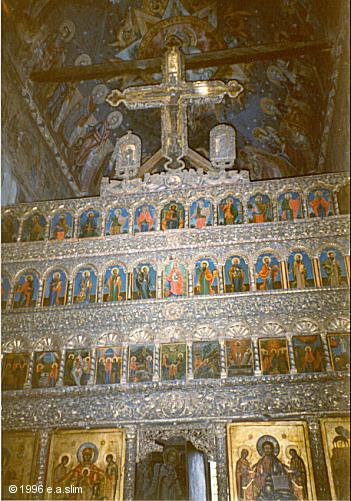 In the winter of 1436-1437, Dracul became prince of Wallachia (one of the three Romanian provinces) and took up residence at the palace of Tirgoviste, the princely capital. Vlad Tepes followed his father and lived six years at the princely court. In the winter of 1436-1437, Dracul became prince of Wallachia (one of the three Romanian provinces) and took up residence at the palace of Tirgoviste, the princely capital. Vlad Tepes followed his father and lived six years at the princely court.
In 1442, for political reasons, Dracula and his younger brother Radu were taken hostage by the Sultan Murad II; Dracula was held in Turkey until 1448, while his brother Radu decided to stay there until 1462. This Turkish captivity surely played an important role in Dracula's upbringing; it must be at this period that he adopted a very pessimistic view of life. Indeed, the Turks set him free after informing him of his father's assassination in 1447 - organized by Vladislav II. He also learned about his older brother's death (Mircea was the eldest legitimate son of Dracul) and how he had been tortured and buried alive by the boyars of Tirgoviste.
We visited the remains of the palace which still can be found in Tirgoviste. The ruins also includes a tower and a church which are in contrast of the palace compleately intact. From outside the tower we had a great view over the palace. Inside the tower their was a little Vlad Tepes exhibition.
The church located nearby the palace-remains is the original one where Dracula went to church and has a very impressive interior filled with woodcarved furnitures and paintings and sculptures all over the walls.
 After we had visited the palace with walked through the surrounding part of the town were we found two beautiful Vlad Tepes busts. These busts profed that Vlad Tepes is an important person in the romanian history, primarily because of his successful military exploits against the Ottoman Turks who overran much of southeastern Europe After we had visited the palace with walked through the surrounding part of the town were we found two beautiful Vlad Tepes busts. These busts profed that Vlad Tepes is an important person in the romanian history, primarily because of his successful military exploits against the Ottoman Turks who overran much of southeastern Europe
After our visit in Tirgoviste we drove back to the north-west of Romania. It was in the beginning of the evening and it was getting dark soon so it was time to find a place to spend the night. On the way to the city Curtea De Arges we came across a bunch of cows who were walking from the fields to their stables. In Romania the farmers don't have their own fields with a gate around it; all the cows all grazing in the "wilderness". At the end of the days all the cows are steady walking back to their homes just accompaned by one farmer. When the cows walk through the village they just know the way to their own farm. I can tell you this: it takes a long time to drive through a city when you are surrounded by fifty cows. And although we were a little scared about if one of the cows would damage our car it was also a very nice experience.
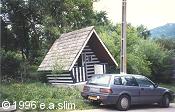 After Curtea De Arges we found a nice little camping nearby the hamlet Albesti were we slept in a little cabana. We were very anxious that evening about the destination of the next day: the legendary Dracula castle in Arefu. After Curtea De Arges we found a nice little camping nearby the hamlet Albesti were we slept in a little cabana. We were very anxious that evening about the destination of the next day: the legendary Dracula castle in Arefu.
Arefu
Early in the morning of the 7th day of our Dracula-tour we drove towards a little town called Arefu folowing the Arges river. On a high mountain in the carpathians in the nearby of Arefu was the location of the legendary Poenari Castle, which is the most important of all the Vlad Tepes sites in Romania. The italic text below is a quotation from Elizabeth Miller's "Reflections On Dracula" book which gives a very good image of the place.
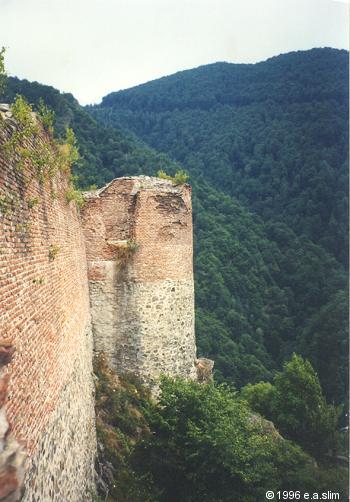 
If there is a "Castle Dracula", this it is. Romanians call it "Cetate Poenari", for it is a fortress rather than a castle. The structure is a partially restored ruin situated on a crag some 1200 feet above a gorge that runs from the Arges Valley through the mountains that seperate Wallachie and transylvania. It has no connection with Bram Stoker's novel but it is central to the story of Vlad Tepes.
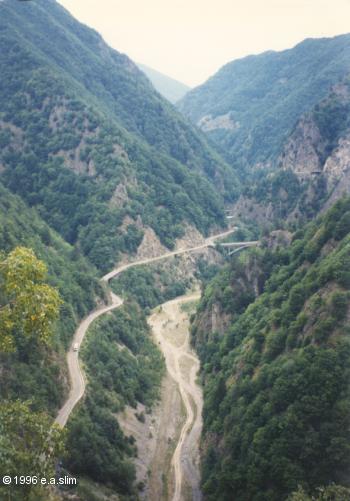
The gruesome story of the construction of this fortress is well documented. In 1457, Vlad Dracula invited the boyars (nobles) whom he held responsible for the death of his elder brother Mircea, to a feast in Tirgoviste. After his guest finished their meal Vlad's soldiers surrounded them, rounded up the able-bodies and marched them fifty miles up the Arges river to Poenari, where they were forced to build his mountain fortress. His prisoners laboured under very difficult conditions for many months. Those who survived the gruelling ordeal were impaled. For Vlad, its inaccessibility served well as a refuge from encroasing enemies, while its strategic location afforded advance warning of attack.
To reach the fortress, you must climb about 1500 steps up the only accesible side of the mountain and cross a narrow wooden foot-bridge! The climb is worth the effort.The fortress is perched on the summit; it walls look like extensions of the side of the mountain. The view of the Arges gorge is breathtaking and the sense of history is overwhelming.
The visit of this legendary Dracula site was the highlight of our trip through Roamania.
the South-Carpathians
 From Poenari we drove further towards the Vidraru lake which we had to cross by driving over the weir. On the top of a mountain is a gigantic sculpture which "looks over" the lake. Again I (alone this time) climbed a lot of stairs to get to this figure. From there I had a very beautiful view over the lake and the surrounding. From Poenari we drove further towards the Vidraru lake which we had to cross by driving over the weir. On the top of a mountain is a gigantic sculpture which "looks over" the lake. Again I (alone this time) climbed a lot of stairs to get to this figure. From there I had a very beautiful view over the lake and the surrounding.
After that we drove further into the South-Carpathians and we climbed higher and higher. At one moment we drove into the clouds and soon after that we got at the top of the Bilea Lac. This pass is 2000 meters above sealevel and you can walk into the snow there (as we did of course).
And then suddenly after we crossed the pass we came into a totally different landscape as we passed the Carpathians and came at the very beautiful flat erea of Transylvania. Soon after that we came at a town called Hunedoara.
Hunedoara Castle
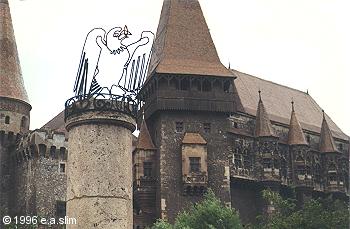 The town Hunedoara is situated in the shadow of a big rusty factory and everything in it is covered under the dust and smell of it. But this town has also one of the most "Draculesque-castle"" in Romania. This so called Hunedoara-castle is the most important monument of the 14th century gothic architecture in transylvania! If you are in the neighborhood you absolutely have to visit this castle. The town Hunedoara is situated in the shadow of a big rusty factory and everything in it is covered under the dust and smell of it. But this town has also one of the most "Draculesque-castle"" in Romania. This so called Hunedoara-castle is the most important monument of the 14th century gothic architecture in transylvania! If you are in the neighborhood you absolutely have to visit this castle.
We walked into the castle and after we had lefted it we had absolutely seen no living person into it including any staff! Coming it strong, the castle was in contrast of other castles totally empty, there was absolute no furniture or anything else between the dark mysterious walls of the castle. The atmosphere in the cold rooms and the dark passages and stairs was very beautifull, sometimes even spooky. You could actually suggest that you might walk against Dracula himself into one of the rooms, although this castle has nothing to do with Vlad Tepes.
But maybe the count lives into it nowadays...
Hunedoara was the last visit of our trip through Dracula's Roamania. After that we drove back to the village of Petris were our trip also began. We stayed a few days at the farm as our vacation came to an end as also this story does.
The End
I hope you enjoyed the story and the photo's I made. This trip to Romania was one of the bests vacations I'll ever had and I hope to see this beautiful land back again in the near future. I'll hope that this story actually can convince you to visit this land, if you are interrested in Dracula or not. The beautiful landscapes of Romania and the very friendly people who live their will make your trip to an experience you never will forget.
Greetings,
sL!m Hengelo, The Netherlands, february 2000
update: sL!m Deventer, The Netherlands, september 2002
| 

 At that moment it started to rain very hard (the only day we had bad weather) so we didn't do anything the rest of the day except having a good diner in the hotel, taking a nice shower (a luxury on this trip) and reading some books.
At that moment it started to rain very hard (the only day we had bad weather) so we didn't do anything the rest of the day except having a good diner in the hotel, taking a nice shower (a luxury on this trip) and reading some books. After that we drove to Sinaia, a city southward from Brasov were we visited one of the most touristic highlights of Romania: manorhouse Peles. This royal residence was built by king Carol 1 in 1883 and is still filled with beautiful furniture and more royal luxury. Manorhouse Peles has been kept very well. One of the main reasons for that is that former romanian dictator Ceausescu did not stayed much in it because he thought there were mildews in it....
After that we drove to Sinaia, a city southward from Brasov were we visited one of the most touristic highlights of Romania: manorhouse Peles. This royal residence was built by king Carol 1 in 1883 and is still filled with beautiful furniture and more royal luxury. Manorhouse Peles has been kept very well. One of the main reasons for that is that former romanian dictator Ceausescu did not stayed much in it because he thought there were mildews in it....
 In the winter of 1436-1437, Dracul became prince of Wallachia (one of the three Romanian provinces) and took up residence at the palace of Tirgoviste, the princely capital. Vlad Tepes followed his father and lived six years at the princely court.
In the winter of 1436-1437, Dracul became prince of Wallachia (one of the three Romanian provinces) and took up residence at the palace of Tirgoviste, the princely capital. Vlad Tepes followed his father and lived six years at the princely court.  After we had visited the palace with walked through the surrounding part of the town were we found two beautiful Vlad Tepes busts. These busts profed that Vlad Tepes is an important person in the romanian history, primarily because of his successful military exploits against the Ottoman Turks who overran much of southeastern Europe
After we had visited the palace with walked through the surrounding part of the town were we found two beautiful Vlad Tepes busts. These busts profed that Vlad Tepes is an important person in the romanian history, primarily because of his successful military exploits against the Ottoman Turks who overran much of southeastern Europe
 After Curtea De Arges we found a nice little camping nearby the hamlet Albesti were we slept in a little cabana. We were very anxious that evening about the destination of the next day: the legendary Dracula castle in Arefu.
After Curtea De Arges we found a nice little camping nearby the hamlet Albesti were we slept in a little cabana. We were very anxious that evening about the destination of the next day: the legendary Dracula castle in Arefu. 


 From Poenari we drove further towards the Vidraru lake which we had to cross by driving over the weir. On the top of a mountain is a gigantic sculpture which "looks over" the lake. Again I (alone this time) climbed a lot of stairs to get to this figure. From there I had a very beautiful view over the lake and the surrounding.
From Poenari we drove further towards the Vidraru lake which we had to cross by driving over the weir. On the top of a mountain is a gigantic sculpture which "looks over" the lake. Again I (alone this time) climbed a lot of stairs to get to this figure. From there I had a very beautiful view over the lake and the surrounding. The town Hunedoara is situated in the shadow of a big rusty factory and everything in it is covered under the dust and smell of it. But this town has also one of the most "Draculesque-castle"" in Romania. This so called Hunedoara-castle is the most important monument of the 14th century gothic architecture in transylvania! If you are in the neighborhood you absolutely have to visit this castle.
The town Hunedoara is situated in the shadow of a big rusty factory and everything in it is covered under the dust and smell of it. But this town has also one of the most "Draculesque-castle"" in Romania. This so called Hunedoara-castle is the most important monument of the 14th century gothic architecture in transylvania! If you are in the neighborhood you absolutely have to visit this castle.